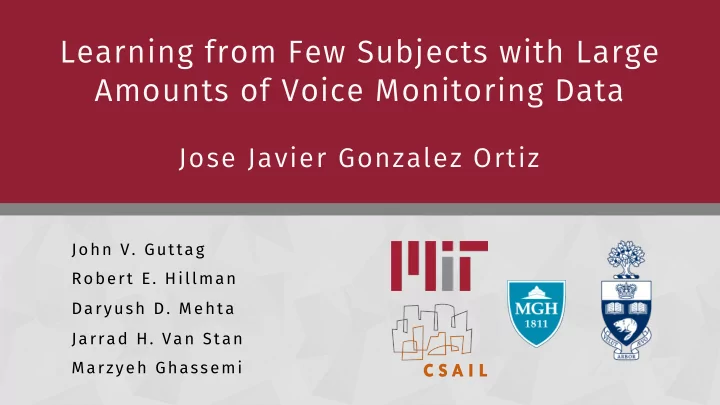

Learning from Few Subjects with Large Amounts of Voice Monitoring Data Jose Javier Gonzalez Ortiz John V. Guttag Robert E. Hillman Daryush D. Mehta Jarrad H. Van Stan Marzyeh Ghassemi
Challenges of Many Medical Time Series • Few subjects and large amounts of data → Overfitting to subjects • No obvious mapping from signal to features → Feature engineering is labor intensive • Subject-level labels → In many cases, no good way of getting sample specific annotations 1 Jose Javier Gonzalez Ortiz
Challenges of Many Medical Time Series • Few subjects and large amounts of data → Overfitting to subjects Unsupervised feature • No obvious mapping from signal to features extraction → Feature engineering is labor intensive • Subject-level labels Multiple Instance → In many cases, no good way of getting sample Learning specific annotations 2 Jose Javier Gonzalez Ortiz
Learning Features • Segment signal into windows • Compute time-frequency representation • Unsupervised feature extraction Conv + BatchNorm + ReLU Pooling 128 x 64 128 x 64 Dense Upsampling Sigmoid 3 Jose Javier Gonzalez Ortiz
Classification Using Multiple Instance Learning • Logistic regression on learned features with subject labels Raw Logistic Waveform Regression Spectrogram Encoder Prediction • % Positive Per Window Per Subject Per Window Per Subject • Aggregate prediction using % positive windows per subject 4 Jose Javier Gonzalez Ortiz
Application: Voice Monitoring Data • Voice disorders affect 7% of the US population • Data collected through neck placed accelerometer 1 week = ~4 billion samples ~100 5 Jose Javier Gonzalez Ortiz
Results Previous work relied on expert designed features [1] Comparable AUC Accuracy performance Train 0.70 ± 0.05 0.71 ± 0.04 wi with thout t Expert LR task-specific Test 0.68 ± 0.05 0.69 ± 0.04 feature Train 0.73 ± 0.06 0.72 ± 0.04 engineering! Ours Test 0.69 ± 0.07 0.70 ± 0.05 [1] Marzyeh Ghassemi et al. Learning to detect vocal hyperfunction from ambulatory neck-surface 6 Jose Javier Gonzalez Ortiz acceleration features: initial results for vocal fold nodules. IEEE Trans. Biomed Engineering
Summary • Our method learns features from large time series data • Reduces the need for laborious task-specific feature engineering • Applied to large voice monitoring dataset • Comparable performance to previous work that relied on expert engineered features 7 Jose Javier Gonzalez Ortiz
Recommend
More recommend